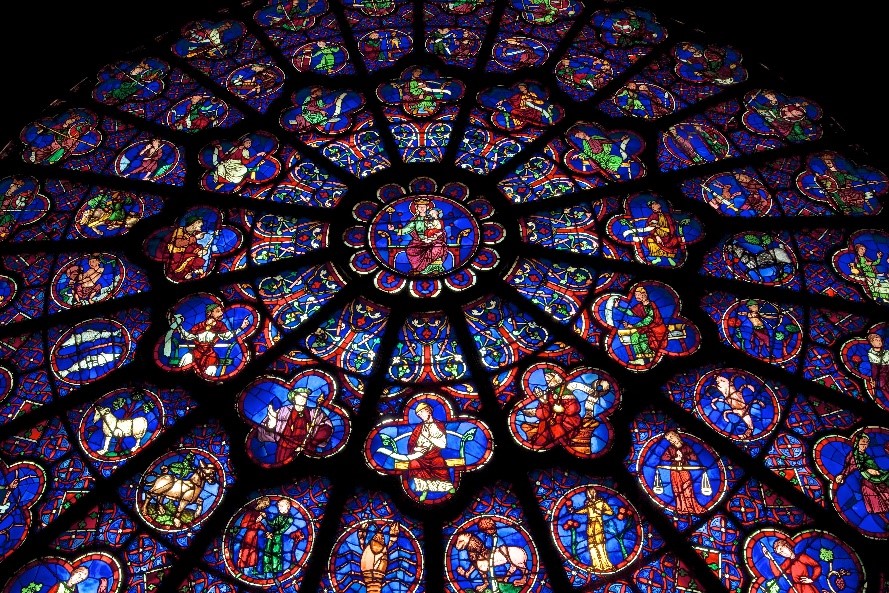One of the most well-known features of Notre-Dame de Paris are her expansive stained-glass windows, including the three magnificent rose windows.
The Art of Stained Glass
The artistry of stained glass quickly gained prominence in the 12th century. These large, colorful windows became a staple in Gothic architecture, bathing many newly constructed cathedrals in the Middle Ages in colorful light, like Chartres Cathedral and Notre-Dame Cathedral and Sainte-Chapelle in Paris.
In order to create the vibrant color intensity, large quantities of pigment are needed. These pigments were often rare and expensive, and sourced from distant countries. The striking blues in Notre-Dame de Paris’s windows, for example, is created using lapis lazuli, a blue stone mined in Afghanistan.

Notre-Dame de Paris’s Stained-Glass
Notre-Dame Cathedral’s stained-glass windows are considered a masterpiece of Gothic art. Collectively, the stained-glass windows cover almost 1,100 square feet (a thousand of square meters) of surface area. The images depicted in the windows show religious scenes and stories. As many parishioners were illiterate at the time of the cathedral’s construction, this was a way to explain the Scriptures and stories of the saints to worshippers and exalt the glories of the church.
Over time, weathering affected Notre-Dame Cathedral’s stained-glass windows, which were never cleaned or restored. As a result, the clarity and vibrancy of the windows faded, and by the 18th century, their bright and colorful effect disappeared. During the reign of King Louis XV, Notre-Dame Cathedral’s priests destroyed some of the medieval stained-glass windows and replaced them with white glass for a clearer and more modern feel.
In the early 20th century, these white glass windows were replaced at the request of Cardinal Verdier. Master glassmaker Jacques le Chevallier proposed the first figurative project for new stained-glass windows in 1938. When World War II broke out, the 12 upper windows were lowered to avoid damage. After the war, le Chevallier received a new commission from Historic Monuments for a more innovative project. He created a non-figurative series, breaking with the Gothic style. For le Chevallier, abstract art carried a strong spiritual dimension. The windows were installed in 1966 and are still visible today.
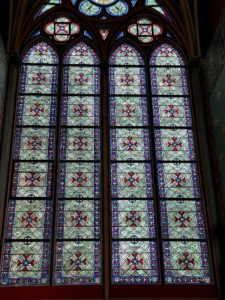
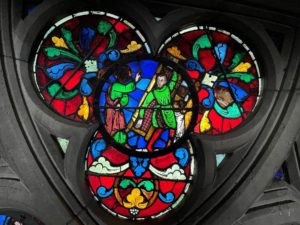
Notre-Dame Cathedral’s Rose Windows
The most notable of Notre-Dame de Paris’ stained-glass windows are its three rose windows. The rose windows are set in the north, south, and west facades of the cathedral. The south rose window, also called the “midday rose” was given to Notre-Dame Cathedral by the king of France Saint Louis IX. The window was constructed around 1250 and depicts the Last Judgement over 84 panels.
Sitting directly opposite the south rose window is the north rose window, also constructed around 1250. It is the only rose window that still contains most of its original glass from the 13th century. It depicts Mary enthroned holding the Christ Child, surrounded by kings and prophets from the Old Testament.
The colors of the south and north rose windows were thoughtfully chosen, taking into consideration the effect of sunlight hitting the cathedral at different times of the day. The south rose window boasts more reds while the north rose window contains more blues.
The west rose window is found above the entrance of Notre-Dame de Paris. The oldest window, originally completed around 1225, none of the original glass survives today. The central image is of the Madonna and Child, and it also depicts the Vices and Virtues, as well as stories from the Zodiac and the Labors of the Months.
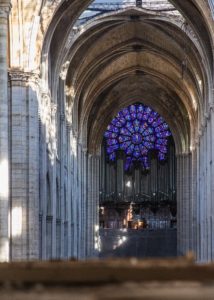
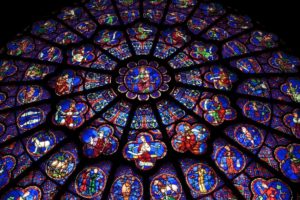
The Stained-Glass Windows after the Fire
Fortunately, all the stained-glass windows survived the fire in April 2019. They will undergo much needed restoration to repair smoke and lead damage, and wear-and-tear incurred over decades of weathering.
When Notre-Dame Cathedral reopens to the public, these windows will once again cast a vibrant glow over the cathedral’s interior.
Sign up for the Friends of Notre-Dame de Paris newsletter to receive updates about the cathedral. And you can donate to Notre-Dame de Paris’ restoration here!
